Technology
Top 10 Document Management Software For Small To Midsize Businesses
Published
3 years agoon

Are you looking for a reliable tool to help you organize your digital documents or digitize your existing paper records? Document management software is the solution to your worries. It encompasses variety of features essential for efficient business operations. Small and midsize businesses (SMBs) nowadays want to go paperless and are searching for the right solution. So, if you’re one of those SMBs who want to succeed, choose one from the top ten document management software especially designed for you.
1. Ascensio System OnlyOffice
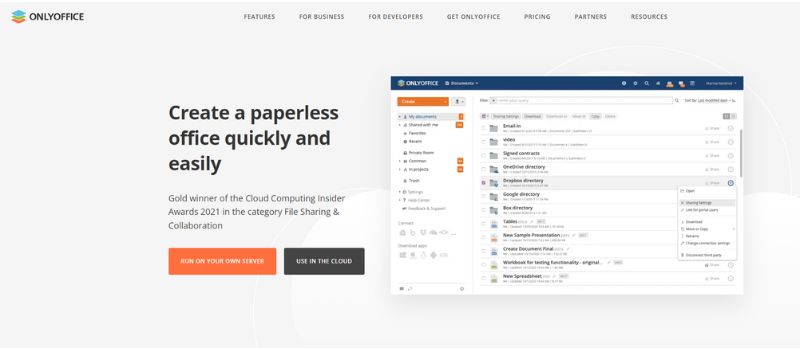
Store your files in one place and access them anywhere, from you computer, smartphone, or tablet with Ascensio System OnlyOffice. It is an effective document management software for SMBs with cloud-based and on-premise plans.
Key Features:
- Document Editor
- Spreadsheet Editor
- Presentation Editor
- Form creator
- PDF reader & converter
- Security
Pros:
- Budget-friendly plans
- Strong set of features
- Simultaneous document editing makes collaboration easier
Cons:
- Compliance features need improvement
- Corporate directory integration for cloud version is not available
2. Microsoft SharePoint
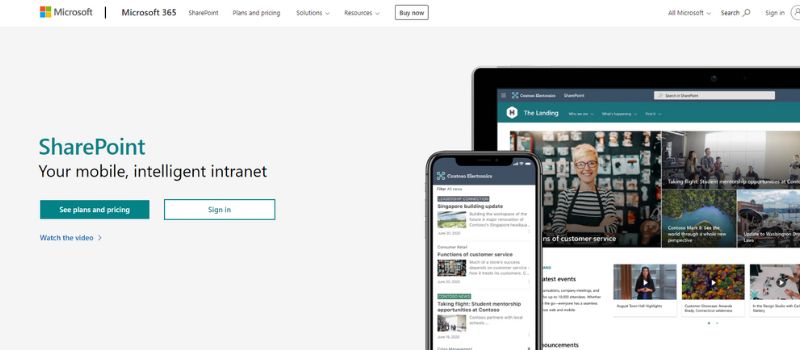
If you’re looking for a tool that combines workflow, document management, and team collaboration, Microsoft SharePoint Online is a number one choice. Microsoft SharePoint is a leading document management and collaboration space because of its comprehensive platform for businesses. It allows you to create personalized metadata fields for files stored in the system, making it easy to customize the way you organize your documents.
Key Features:
- Business intelligence
- Document library accessibility
- Expanded file names
- Folder sharing
- Better integration with Office 365
- Large file support
- Security
Pros:
- Robust ecosystem of third-party integrations.
- Much easier to use than before.
- Available separately or packaged with Microsoft Office 365.
- Highly configurable workflows.
Cons:
- Experts are needed for installation.
- Expensive
3. M-Files
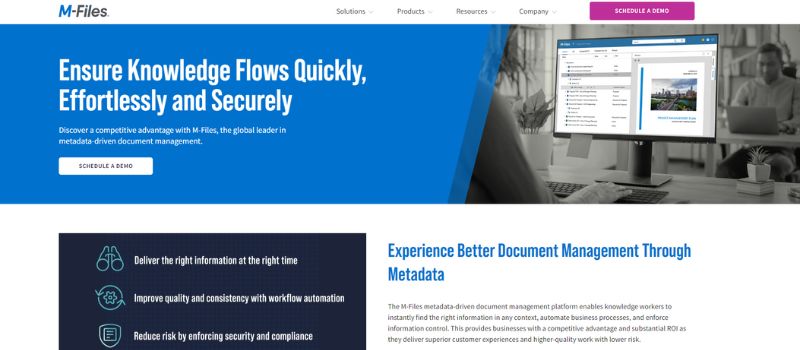
M-Files is a comprehensive document management system with an intuitive and easy-to-learn interface. It can serve a variety of industries, including accounting, consulting, engineering, energy, financial services, manufacturing, real estate, and professional services.
Key Features:
- API
- Access Controls/Permissions
- Archiving & Retention
- Audit Trail
- CRM
- Collaboration Tools
- Compliance Tracking
- Content Management
Pros:
- Easy to use
- Document management
- Version control
Cons:
- Inadequate customer support
- Set-up not user-friendly
- Incomplete admin tools
4. DocuWare Cloud
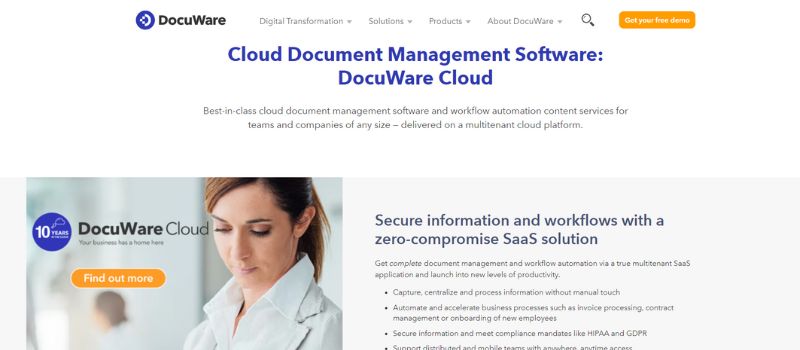
DocuWare Cloud is a superior cloud-based document management software for teams and businesses of any size. However, it is lacking some of the features found on competing systems.
Key Features:
- Capture and organize information
- Process documents
- Manage workflows
- Access and view content for decision-making
Pros:
- Exceptional form capabilities
- Strong document import and data field capabilities
Cons:
- Limited integrations
- Some features require a separate download
- Sharing functionality needs improvment
5. Hightail Business
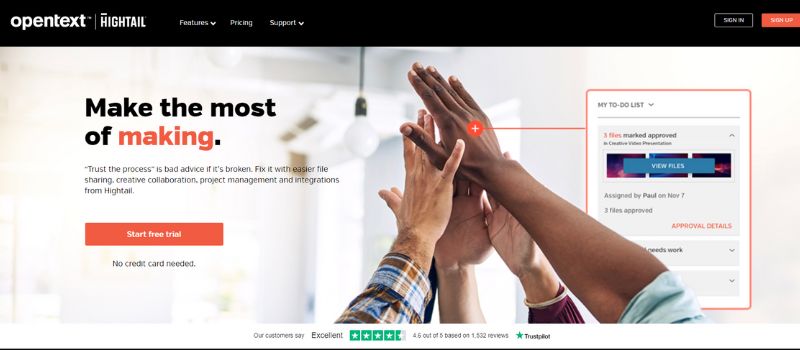
Hightail Business is a document management system that helps creative businesses. That is why it focuses on large files like photos and videos. It has a wide range of features for efficient workflows on small and mid-size businesses.
Key Features:
- File Sharing
- Creative Collaboration
- Project Management
- Apps and Integrations
Pros:
- Targets creative professionals.
- Includes comment and approval tools that initiate a feedback loop with customers.
- Enables easy receipt of files from clients through uplink feature.
Cons:
- Limited support for standard office document types
6. Rubex by eFileCabinet
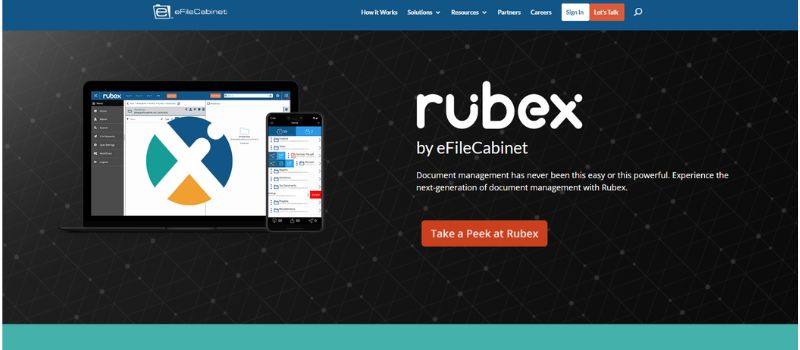
Rubex by eFileCabinet Online is a cloud-based solution that allows remote employees to log in from any computer with internet access and have the exact same functionality as they would have when working from the office.
Pros:
- One-stop solution for securely storing, managing, and sharing business documents and files
- Solid optical character recognition (OCR)
- Search functionality
- Powerful audit trail features
Cons:
- Unable to edit documents online
- Poor mobile application integration
7. Ademero Content Central
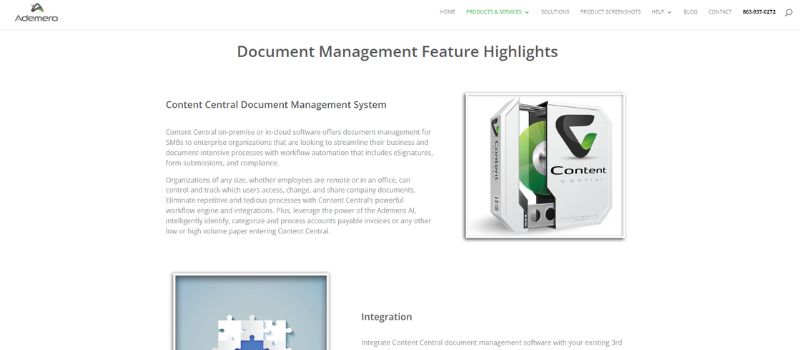
Ademero Content Central has outstanding document scanning capabilities. It specifically features zonal recognition which make gathering metadata faster. However, the solution seems deficient in cloud storage integration and sharing areas.
Key Features:
- Integration
- Access anywhere
- Security
- Document sharing and collaboration
Pros:
- Intuitive administration tools.
- Easy integration with Workaday and Quickbooks.
- Smooth workflow implementations.
- Zonal recognition that improves overall image capture in forms.
- Highly configurable.
Cons:
- Sharing and storage options are limited.
- Pricing for on-premises variant is expensive.
- Pricing options fall behind Editors’ Choice product in value.
8. Adobe Document Cloud Standard
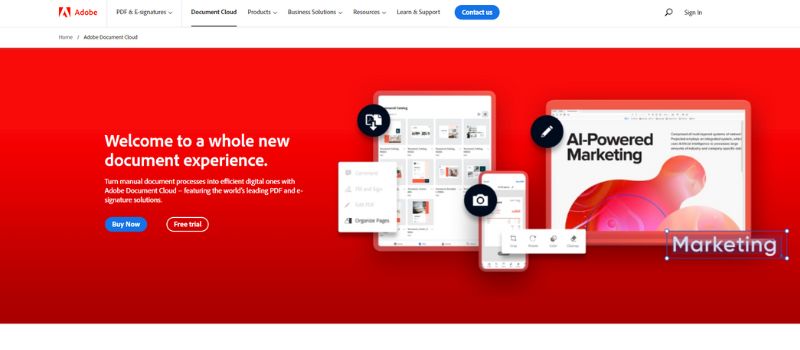
Adobe Document Cloud Standard seems behind its competitors in some functionality. However, it is excellent when it comes to working with forms and legal documents. Your primary focus need to be PDF files to avail Adobe Document Cloud Standard plan.
Key Features:
- Acrobat Standard DC desktop software
- New Acrobat mobile app (iOS, Android)
- Free Document Cloud services
Pros:
- Solid PDF file management, form entry and document export
- Mobile support is an added bonus.
Cons:
- Weaker sharing and collaboration features
- Limited support for other file types besides PDF.
9. Fluix
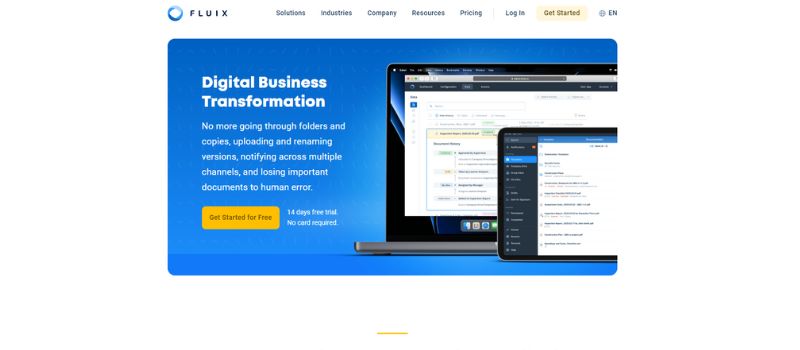
Fluix features impressive document workflows and integration with popular cloud storage providers most SMBs already use. But the tool’s lack of support for sharing, document storage, or enterprise-level features.
Key Features:
- Form Filling
- Form Builder
- E-signature
- TaskStream
- Data Reporting
- Integrations
Pros:
- User-friendly and easy to set up.
- Designed for Apple iPad
- Strong cloud storage and integration features.
Cons:
- Lacks support for collaboration basics such as document creation and sharing
- Focus on iPad for client devices
- No Android support
10. PaperTracer
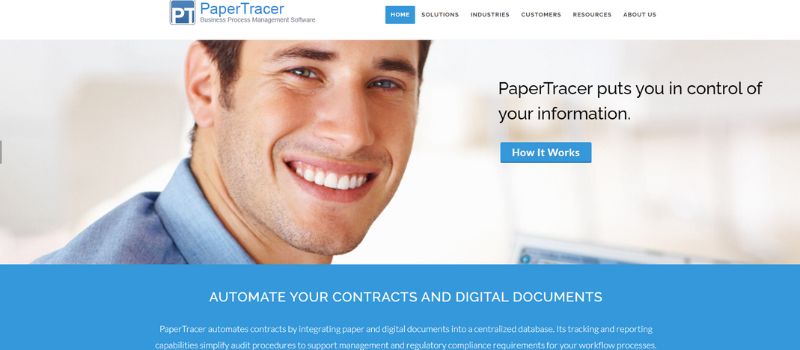
PaperTracer is a cloud-based contract management solution offered by Health Asset Management, Inc. (HAMi). The software helps businesses to streamline their contract management process and automate workflows.
Key Features:
- Audit management
- CRM
- Completion tracking
- Compliance management
- Contrack drafting
- Data extraction, import/export
- Document storage
- Digital signature
Pros:
- Great granular control.
- Superb data handling.
- Abundant workflow templates.
- Many customization features.
Cons:
- Limited to PCs with Microsoft’s IE 11 browsers running the Silverlight 5 plug-in.
- Minimal collaboration and sharing features.
- Storage requirements can quickly drive up costs.
Conclusion
Scattered and disorganized documents in a workplace can ruin productivity. That is why you need a trusted document management software. It plays a huge role in making the tasks related to documentation a lot easier, faster, and more efficient.
You may like
Technology
Meta Quest 3 vs PlayStation VR2: Which to Buy in 2025?
Published
4 weeks agoon
October 2, 2025
In just a few years, virtual reality has made significant strides. The release of Meta Quest 3 and PlayStation VR2 has sparked debates over which headset is the best. So, if you’re a casual gamer, a tech enthusiast, or just a fan of immersive entertainment, this article can help you choose between the two. Let’s break it down.
These two are regular placers on lists of the best headsets, thanks to their lower price. However, what makes these VR headsets great is that despite the lower price, they deliver high quality. If you’re looking for VR headsets that are less expensive, these two are excellent options. Here’s a head-to-head review of Meta Quest 3 vs PlayStation VR2:
Design and Setup
Meta Quest 3 comes from a long line of Meta’s standalone, wireless VR. You won’t need a PC or console to run this bad boy. It’s also totally portable, setting up in seconds and allowing you to jump straight into the game or mixed reality experiences. Its new Touch Plus controllers are designed to be more ergonomic, making hand tracking smoother than ever.

On the other hand, PlayStation VR2 is tethered to a PlayStation 5. This means you have to deal with a cable, which can be a small price to pay for more powerful visuals and deeper immersion. Its headset boasts impressive features, including eye tracking, haptic feedback, and adaptive triggers. This allows for the headset to feel like an extension of your body rather than a piece of technology.

Visuals and Performance
Both headsets offer impressive display quality:
- Meta Quest 3: has a resolution of 2064×2208 per eye, a 120Hz refresh rate, and a broader field of view than its predecessor.
- PSVR2: displays 2000×2040 per eye on an OLED panel, also featuring a 120Hz refresh rate and HDR support for richer colors and deeper blacks.
It’s clear that Quest 3 has slightly higher resolution, however, PSVR2’s OLED display and eye tracking make it more realistic and responsive.
Game Library
Focusing more on a strong lineup of standalone VR titles, Meta Quest 3 features Laser Matrix, BlackGate, and Tracked: Shoot to Survive. It also supports many of the classics from Quest 2, such as Beat Saber, Superhot VR, and Resident Evil 4 VR. You can find more at Meta’s store as it continues to grow, with mixed reality experiences thrown in.
PSVR2 is ideal for those into cinematic and console-quality games. It offers titles like Astro Bot, Horizon Call of the Mountain, Hitman 3, and Aces of Thunder that powerfully show what the hardware can do. If you’re already a PS5 gamer, you’ll find a smooth transition into VR gaming with familiar franchises and high-end polish.
Price and Value
- Meta Quest 3 prices start at around $500, with a budget-friendly Quest 3S model for $300.
- PSVR2 is priced at $399.99, but it requires a PlayStation 5, which can increase the overall cost.
So, if you’re starting from scratch, Quest 3 gives better value. However, if you already own a PS5, PSVR2 becomes the more appealing option.
Final Verdict
So, which VR headset should you go for in 2025?
– Go with Meta Quest 3 if you want to be free from wires. You’ll love its portability and enjoy a growing library of standalone and mixed reality games.
– Choose PlayStation VR2 if you love high-end visuals. Its console integration and immersive gameplay push the boundaries of what VR can do, which can be a strong deciding factor for some.
Both headsets are excellent in their own right. The only factor worth considering is the type of experience you’re seeking.

It’s a little surprising to most people that cloud-based software is behind most operations on the internet. Cloud services comprise a considerable component of the international information technology infrastructure as it provides means of Data Storage and Access.
Furthermore, it’s also a means to develop, grow, and maintain applications and databases on the world wide web. If you have a company, there needs to be some sort of central command point that stores your information and operates your requirements.
Essentially, a cloud-based application is defined by a program that manages the storage and housing of information. The following are typical examples of what cloud-based software includes:
- Storage, servers, and networking
- Possibility for developers to build, test and operate applications
- The ability for users to connect to web-based and mobile applications
Here are some cloud-based software examples you’ll want to check out.
1. Amazon Web Services
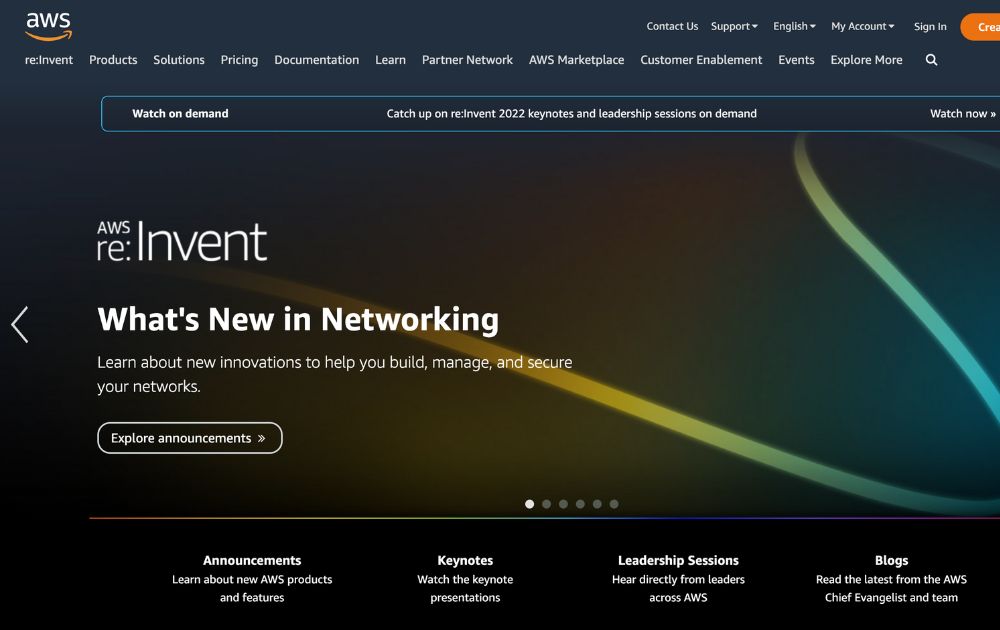
Amazon Web Services is one of the largest and best cloud computing services out there. It has a comprehensive set of computation, storage, and database solutions developers need for projects. Aside from these advantages, it’s also widely used – in fact, it’s currently available in 84 zones across 26 regions. Plus, it can be used on its own or connected to another cloud computing platform. AWS is free for all users.
2. Google Cloud Platform
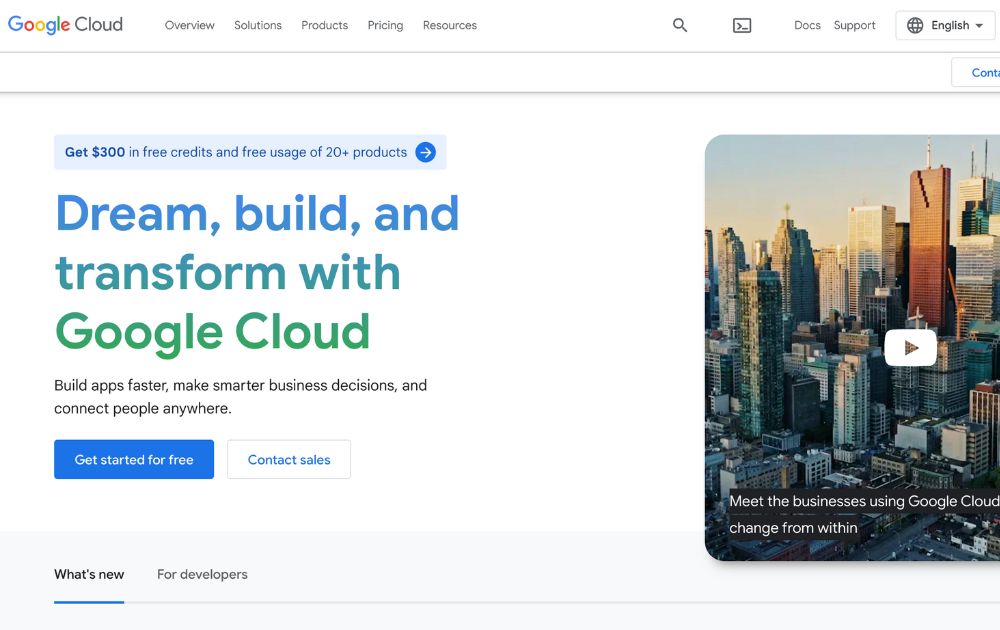
Meanwhile, Google Cloud Platform (GCP) is another public service provider you shouldn’t miss. The GCP is best for developers who want to scale their infrastructure at a quick pace. Aside from that, users can take advantage of the service’s AI, analytics, and data management capabilities. It uses virtual machines and hard disks at Google site centers to facilitate its operations. GCP has free trials for first-time users, but its primary payment method is pay-as-you-go.
3. IBM Cloud
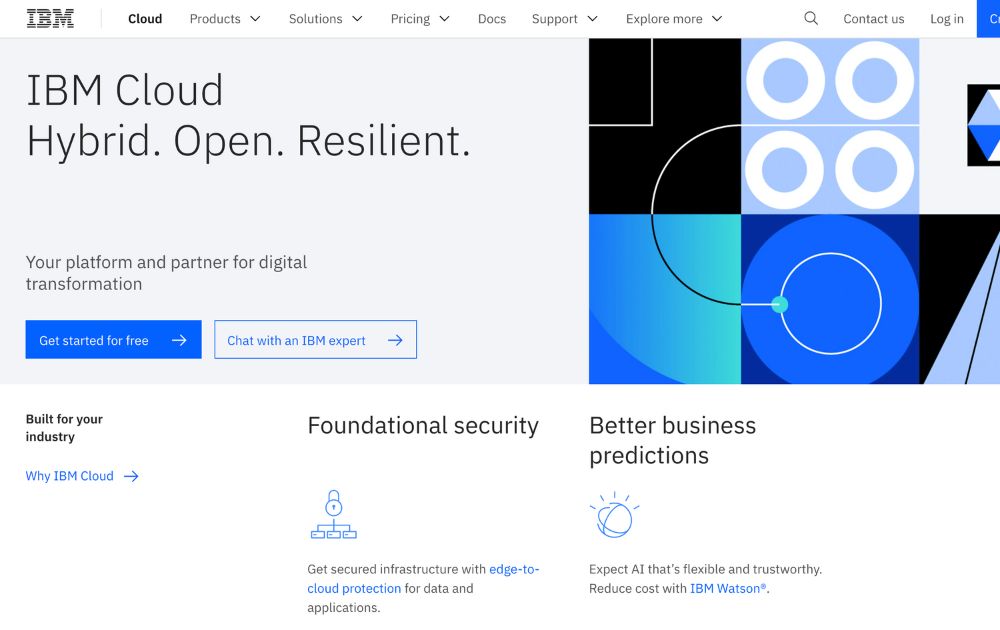
IBM Cloud is a highly customizable service that lets developers choose their preferred tools, data model, and delivery models. Developers can use it on its own, but it’s a service best used with other programs. Users prefer it over other services because of its high reliability, pre-installed security feature, and dual-stack IP capabilities. IBM Cloud is free to use.
4. Microsoft Azure
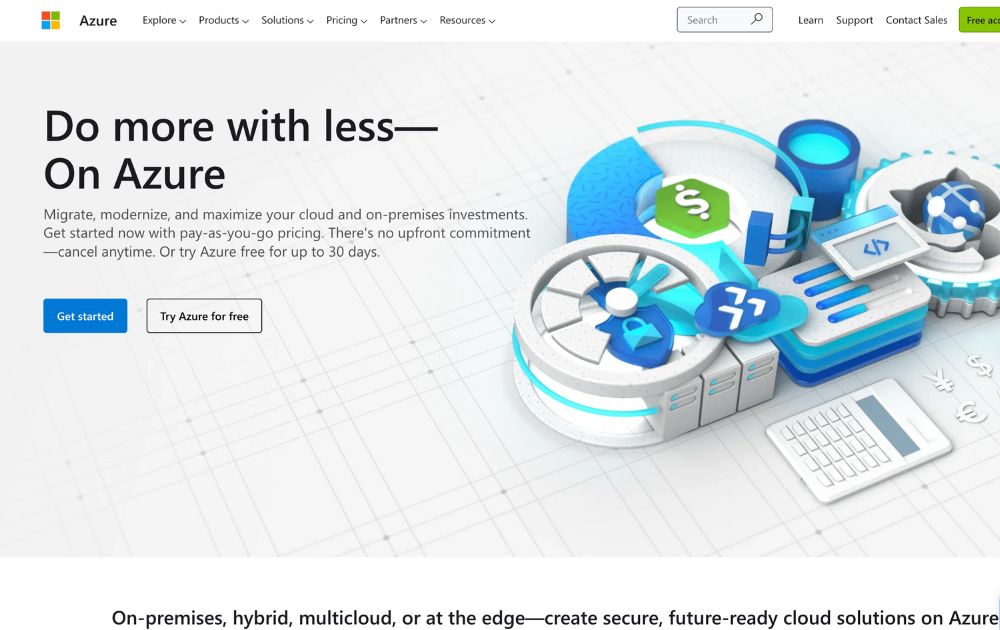
Microsoft Azure is one of the best cloud-based applications if you want a vast network across regions. It’s tailored for developers, and IT teams because of its flexible storage solutions, container and load balancing features, and other core cloud services. Plus, it supports various languages, tools, and operating systems. A free trial of Microsoft Azure will last you for 30 days, but their hourly rate starts at 2 cents per hour for 20GB.
5. Huawei Cloud
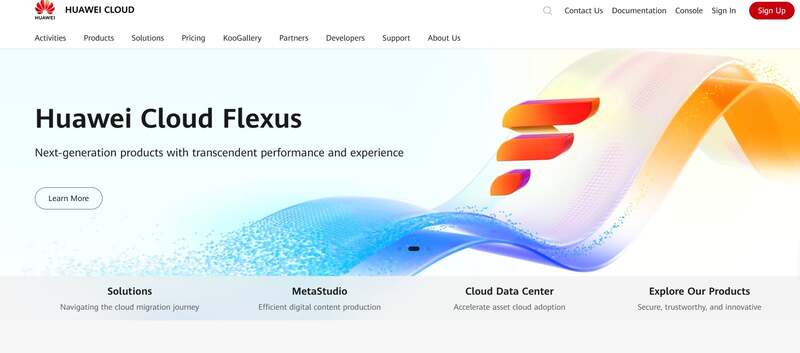
Huawei Cloud is a trusted global cloud service provider featuring robust and secure services to serve enterprises of any size. Computing, storage, and AI-based solutions boast extensive scalability and performance. Generally based out of Asia for extensive applications, Huawei Cloud is rapidly expanding into global markets, becoming a leading competitor for adaptive enterprise cloud needs.
6. Oracle Cloud
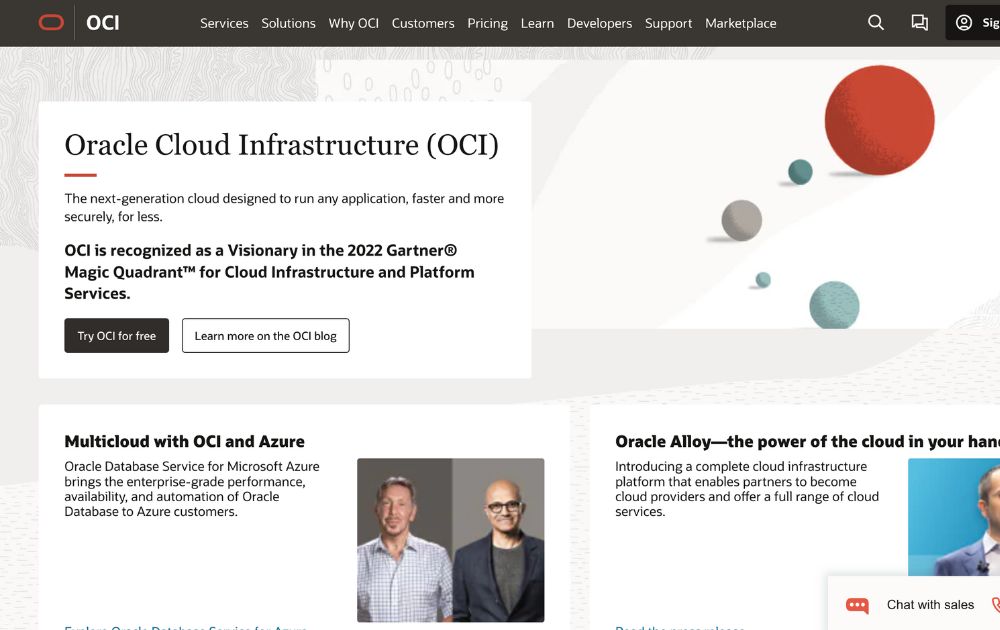
On the other hand, Oracle Cloud also offers basic cloud services tailored to enterprises. It’s suitable for both companies and developers to connect and share their applications online. Like other platforms, it provides storage, network, and applications through its data centers. Like other platforms, Oracle Cloud has tough security and reliable networks to ensure your data’s safety. This option has subscription-based and integrated services for any kind of online business.
7. Alibaba Cloud
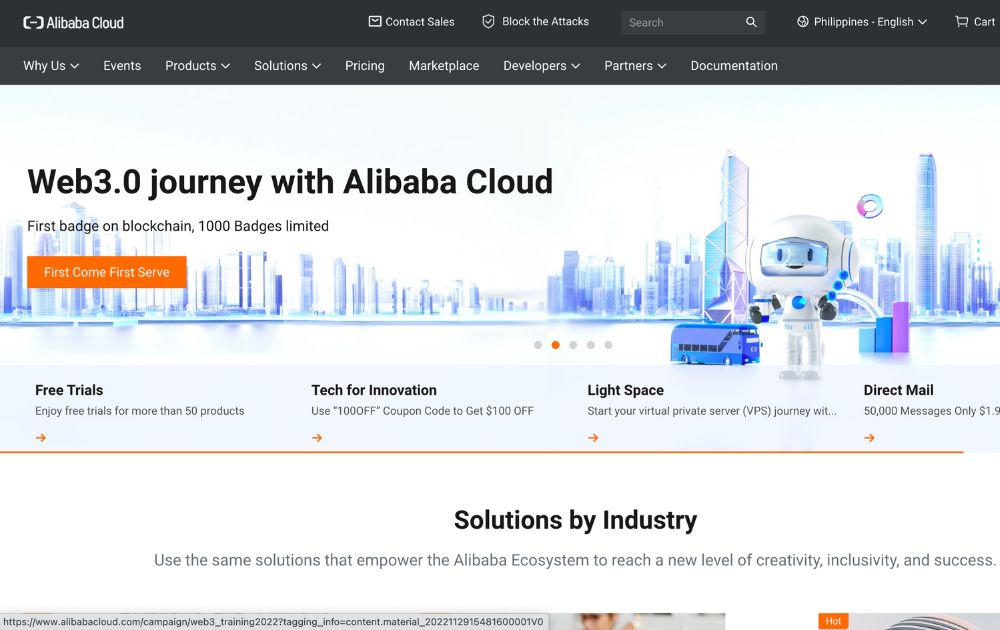
Alibaba Cloud is the leading cloud service provider in Asia and the Pacific, but huge in China. It has all the essential cloud computing services but includes elastic computing, machine learning, big data analytics, and a host of other features. Plus, it’s a scalable option that users can use by itself or with other networks. To date, it has 25 regional centers all over the world. The Alibaba Cloud is available as a pay-as-you-go service.
8. DigitalOcean
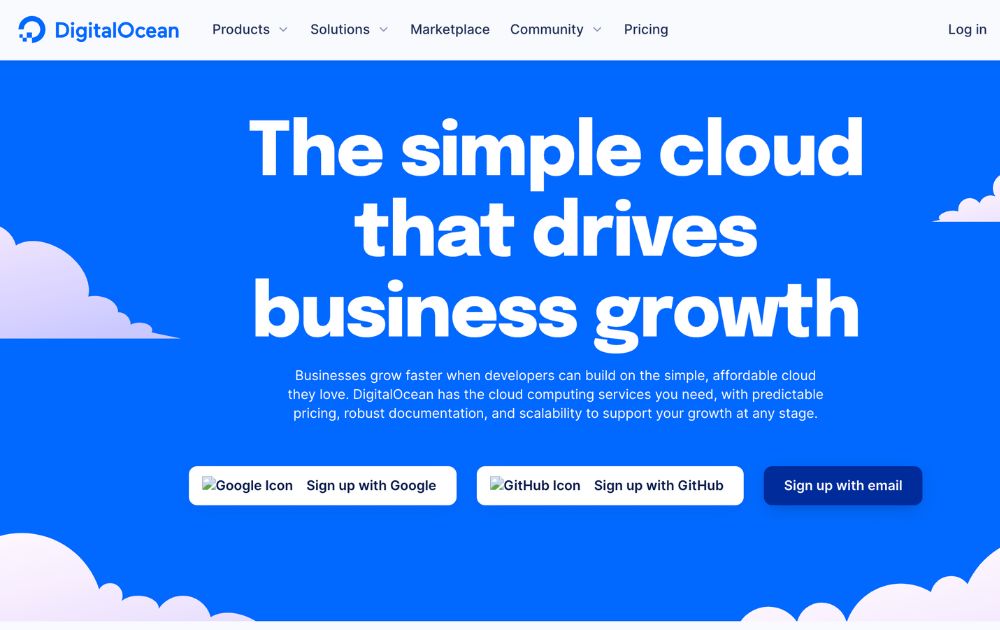
Meanwhile, if you’re looking for a simple option that’s better for small operations, DigitalOcean is for you. DigitalOcean focuses on IaaS and offers all the basic and core tools for only $6 a month. That said, it allows users to create VMs, deploy Kubernetes clusters, manage databases, and more. This option is one of the best for beginners for its friendly interface and cheap plans.
9. Tencent Cloud
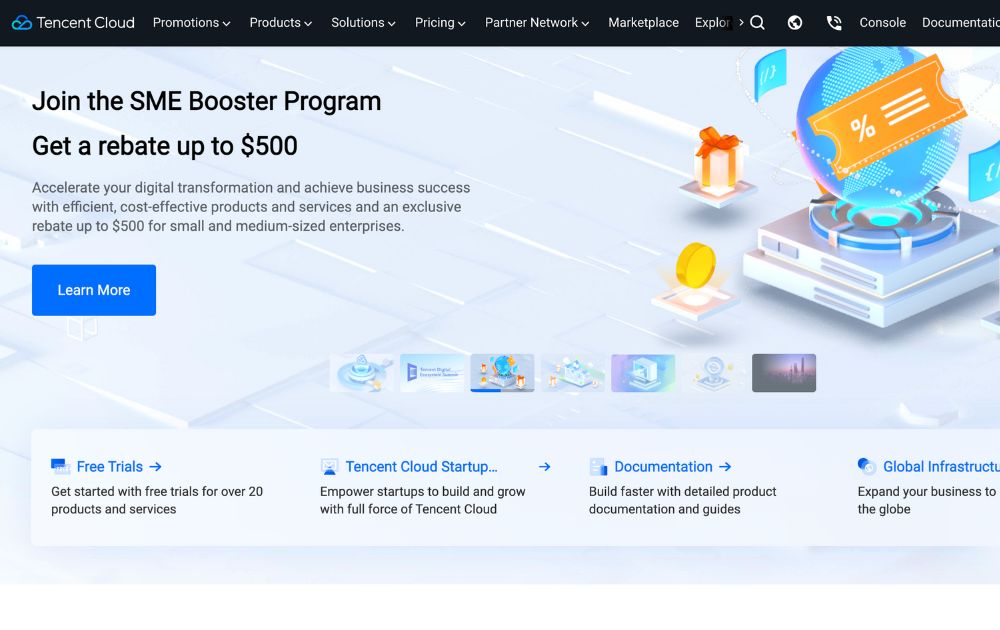
After Alibaba, China’s next largest service provider is Tencent Cloud. It’s a great option for storage, data migration, and analysis. In addition, it has powerful computation abilities with automatic scaling, CVMs, and auto-scaling. Plus, it also has scalable file storage and CDN. Apart from that, users can also get cloud storage and a strong security feature with this option. Tencent Cloud has over 500 locations all over the world.
10. Salesforce
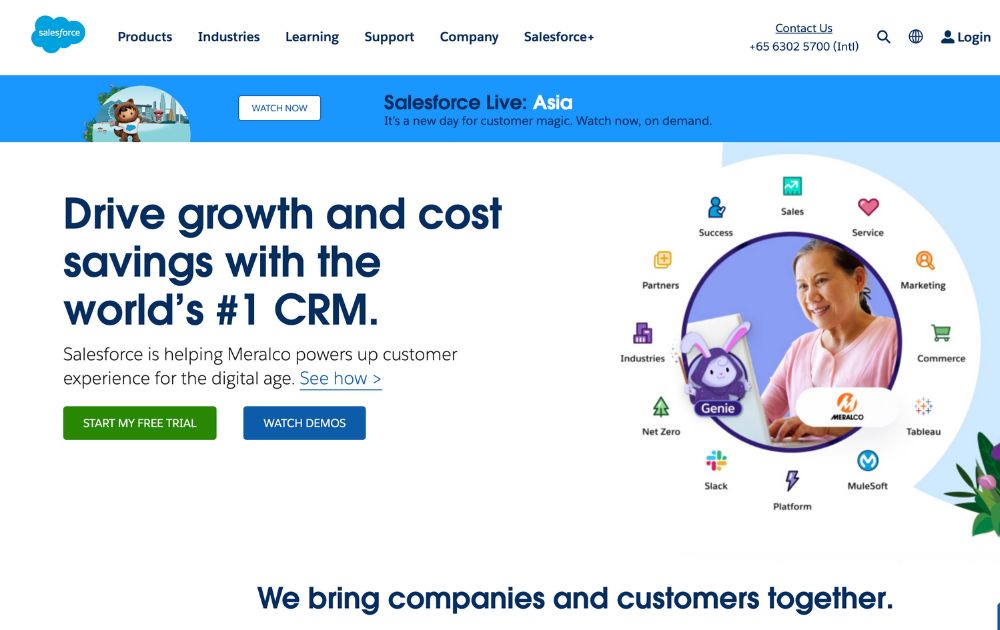
Meanwhile, Salesforce is one of the best cloud-based software solutions for businesses. It has CRM, sales, ERP, mobile apps, and more features. It’s best if you want customer support features to keep track of orders, manage clients, and track leads. You can also choose to add customer service data with records from other clouds. This option starts at $25 per month.
Factors to Consider When Choosing Cloud-Based Software
Need tips to find the best cloud-based software for you? You might want to take a look at these factors first.
First, check how payment works. Most platforms use a pay-per-use method, but others favor subscription-based plans. Next, you want to review their main services and whether they’re fit for your niche. For instance, developers and IT teams are better off with services like AWS and GCP. Salesforce, on the hand, is the best option for online shops and small teams.
You may also want to look at migration support and exit strategies. Some services have a vendor-lock rule that prevents you from moving to other services. Finally, pay some mind to their data management and security policies. You want to make sure your applications are secure and protected. In sum, do your dues and check for the reliability of the service you’re looking at. Check the cloud-based software advantages before making the jump to commit.

Artificial intelligence (AI) technologies continuously evolve and power various processes around us. Similarly, AI is one of the significant growth drivers in the semiconductor industry. It is because AI generates large amounts of data much faster and makes predictions more accurately than humanly possible.
MemryX is a startup focusing on AI processing for edge devices and is creating new technologies to address this emerging market. Let’s take a closer look at MemryX and its future directions.
Company Background
MemryX Inc was established in 2019 by Dr. Wei Lu to create an AI accelerator suitable for Edge devices. Dr. Lu has been an Electrical Engineering and Computer Science professor at the University of Michigan since 2005. He specializes in memory systems, neuromorphic computing, and in-memory computing system. Dr. Lu and his team spent almost three years developing and proving MemryX’s unique approach.
The company’s website lists Dr. Wei Lu as CTO and Co-Founder, while Keith Kressin is the President and CEO. Dr. Mohammed Zidan is the VP of Architecture, and Roger Peene is the company’s VP of Product & Business Development.
Just this March 2025, MemryX has raised $44 million in Series B funding through the support of new and existing investors. Their Series B founding comes at an opportune time of the MemryX’s announcement of the production quality of their MX3 Accelerator chip.

The Target and Flag Plant
Since the start, MemryX’s goal has been to be the leading provider in the edge AI semiconductor market. After all, this industry to projected to grow rapidly over the years because there’s ample demand for low-power and efficient AI accelerators.
Its target has always been industries that need real-time AI processing at the edge, such as automotive, smart devices, healthcare, industrial automation, and IoT.
As mentioned earlier, the company’s flagship product, the MX3 AI Accelerator, has moved beyond initial sampling and is now in full production. Because of this, it has earned industry recognition for its performance and ease of integration. Its innovative dataflow architecture allows developers to deploy complex AI models with minimal energy consumption and latency.

Strategic partnerships, such as its collaboration with the National Semiconductor Hub in Saudi Arabia and membership in the Edge AI Foundation, signal its ambition to expand globally while shaping the standards of the edge AI ecosystem.
The Challenge
Because of the rapid adoption of AI, there’s a challenge to have powerful models out of the cloud and into the real world without being overwhelming to devices in terms of not only power but also heat and complexity.

That said, CPUs, GPUs, and other traditional processors may not be ideal for real-time use beyond their use for training models. With that in mind, MemryX may find various challenges:
- High power consumption. A lot of accelerators drain too much energy, limiting their use in mobile or embedded devices.
- Latency issues. Cloud-based AI introduces delays that are unacceptable for applications like autonomous driving or medical imaging.
- Complex deployment. Running models on diverse hardware often requires extensive optimization and developer expertise.
- Scalability concerns. As models grow larger, businesses need solutions that can keep pace without ballooning costs.
Amid these challenges, MemryX saw an opportunity. It found a way to build a chip architecture with a dataflow-driven design, making edge AI both scalable and accessible.
Conclusion
The successful Series B funding in 2025 and partnerships with organizations like the National Semiconductor Hub in Saudi Arabia and the Edge AI Foundation show that MemryX is no longer just an emerging startup. It is an influential player with global ambitions. Recognition, such as the 2025 Edge AI and Vision Product of the Year Award, further validates its technology and market impact.
In short, MemryX has planted its flag as a serious contender in the semiconductor space, turning vision into execution and execution into momentum.

What’s the Best Graphic Design Service for Startups

What’s the Best Graphic Design Service for Ecommerce Businesses?

What’s the Best Fiverr Alternatives?

What’s the Best Superside Alternatives today?

What are the Best Canva Alternatives for Designers and Marketers?
What’s the Best Design Pickle Alternative?

Top Marketing Podcasts for 2025 You Should Be Following Today

Top Marketing Podcasts for 2025 You Should Be Following Today
What’s the Best Design Pickle Alternative?

What are the Best Canva Alternatives for Designers and Marketers?

What’s the Best Superside Alternatives today?

What’s the Best Fiverr Alternatives?

What’s the Best Graphic Design Service for Startups



